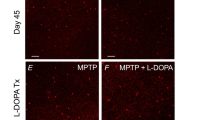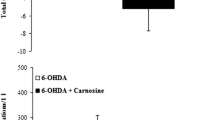Abstract
Both dopamine (DA) and melatonin (MLT) are abundant neuromodulators located in vertebrate retina. The retinal DA deficiency and variations in MLT levels have been linked to Parkinson’s disease (PD). No studies have investigated the ipsilateral and contralateral DA and MLT in retina and their relationships in 6-hydroxydopamine (6-OHDA) induced hemiparkinsonian rats. We established PD rat model by unilateral injection of 6-OHDA into the right substantia nigra and the right medial forebrain bundle. Eye tissue was collected and the levels of MLT and DA were measured twice daily at 10:00 and 22:00. The concentrations of DA and its metabolites, 3,4-dihydroxyphenylacetic (DOPAC) and homovanillic acid (HVA), as well as MLT were determined by HPLC. The results show that DA levels in the eye contralateral to the side of a unilateral intracerebral 6-OHDA lesion significantly decreased (P < 0.001). Both the ratios of DOPAC/DA and HVA/DA were increased in comparison with the vehicle groups after 3 weeks post-lesion. The concentrations of MLT at 10:00 and 22:00 in both eyes were distinctly increased compared with the vehicle groups (P < 0.05). The change of DA and its metabolites, as well as MLT appeared to correlate well with the rotation behavior of rats. These findings suggest that rats receive a unilateral intracerebral injection of 6-OHDA that mainly causes the contralateral eye destruction of DA-containing neurons. Increased retinal MLT level probably is associated with the progression of PD.






Similar content being viewed by others
Abbreviations
- PD:
-
Parkinson’s disease
- DA:
-
Dopamine
- MLT:
-
Melatonin
- NSD:
-
Nigrostriatal dopamine
- RHT:
-
Retinohypothalamic tract
- 6-OHDA:
-
6-Hydroxydopamine
- SNc:
-
Substantia nigra pars compacta
- MFB:
-
Medial forebrain bundle
- INL:
-
Inner nuclear layer
- IPL:
-
Inner plexiform layer
- PBS:
-
Phosphate-buffered saline
- DOPAC:
-
3,4-Dihydroxyphenylacetic acid
- HVA:
-
Homovanillic acid
- HPLC:
-
High performance liquid chromatography
- ANOVA:
-
Analysis of variance
References
Willis GL, Kelly AM, Kennedy GA (2008) Compromised circadian function in Parkinson’s disease: enucleation augments disease severity in the unilateral model. Behav Brain Res 193(1):37–47
Moore RY (1996) Neural control of the pineal gland. Behav Brain Res 73:125–130
Wills GL (2008) Intraocular microinjections repair experimental Parkinson’s disease. Brain Res 1217:119–131
Schernhammer E, Chen H, Ritz B (2006) Circulating melatonin levels: possible link between Parkinson’s disease and cancer risk? Cancer Causes Control 17(4):577–582
Bartell PA, Miranda-Anaya M, McIvor W, Menaker M (2007) Interactions between dopamine and melatonin organize circadian rhythmicity in the retina of the green iguana. J Biol Rhythms 22:515–523
Willis GL (2008) Parkinson’s disease as a neuroendocrine disorder of circadian function: dopamine-melatonin imbalance and the visual system in the genesis and progression of the degenerative process. Rev Neurosci 19(4–5):245–316
Hirayama K, Ishioka T (2007) Impairment in visual cognition in patients with Parkinson disease. Brain Nerve 59(9):923–932
Biehlmaier O, Alam M, Schmidt WJ (2007) A rat model of Parkinsonism shows depletion of dopamine in the retina. Neurochem Int 50(1):189–195
Paxinos G, Watson C (2006) The rat brain in stereotaxic coordinates. Academic Press, San Diego
Sastre Toraño J, Rijn-Bikker P, Merkus P, Guchelaar HJ (2000) Quantitative determination of melatonin in human plasma and cerebrospinal fluid with high performance liquid chromatography and fluorescence detection. Biomed Chromatogr 14(5):306–310
Bungay PM, Newton-Vinson P, Isele W, Garris PA, Justice JB (2003) Microdialysis of dopamine interpreted with quantitative model incorporating probe implantation trauma. J Neurochem 86(4):932–946
Deumens R, Blokland A, Prickaerts J (2002) Modeling Parkinson’s disease in rats: an evaluation of 6-OHDA lesions of the nigrostriatal pathway. Exp Neurol 175:303–317
Hikosaka O, Takikawa Y, Kawagoe R (2000) Role of the basal ganglia in the control of purposive saccadic eye movements. Physiol Rev 80(3):953–978
Forrester J, Peters A (1967) Nerve fibres in optic nerve of rat. Nature 214(5085):245–247
Wree A, Zilles K (1983) Ipsilateral projections to the terminal nuclei of the accessory optic system in the albino rat. Neurosci Lett 43:19–24
Nagel F, Bähr M, Dietz GP (2009) Tyrosine hydroxylase-positive amacrine interneurons in the mouse retina are resistant against the application of various parkinsonian toxins. Brain Res Bull 79(5):303–309
Cuenca N, Herrero MT, Angulo A, de Juan E, Martínez-Navarrete GC, López S, Barcia C, Martín-Nieto J (2005) Morphological impairments in retinal neurons of the scotopic visual pathway in a monkey model of Parkinson’s disease. J Comp Neurol 493(2):261–273
Brandies R, Yehuda S (2008) The possible role of retinal dopaminergic system in visual performance. Neurosci Biobehav Rev 32(4):611–656
Wiechmann AF, Summers JA (2008) Circadian rhythms in the eye: the physiological significance of melatonin receptors in ocular tissues. Prog Retin Eye Res 27(2):137–160
Tosini G, Fukuhara C (2003) Photic and circadian regulation of retinal melatonin in mammals. J Neuroendocrinol 15(4):364–369
Capitelli C, Sereniki A, Lima MM, Reksidler AB, Tufik S, Vital MA (2008) Melatonin attenuates tyrosine hydroxylase loss and hypolocomotion in MPTP-lesioned rats. Eur J Pharmacol 594(1–3):101–108
Ma J, Shaw VE, Mitrofanis J (2009) Does melatonin help save dopaminergic cells in MPTP-treated mice? Parkinsonism Relat Disord 15(4):307–314
Paus S, Schmitz-Hübsch T, Wüllner U, Vogel A, Klockgether T, Abele M (2007) Bright light therapy in Parkinson’s disease: a pilot study. Mov Disord 22(10):1495–1498
Acknowledgments
We thank Dr. Fu-Chou Cheng for criticism, discussion and advice on the manuscript, These studies were supported by grants from the Natural Science Foundation of Fujian Province (No. 2010J01175) and Professor Foundation of Fujian Medical University (No. JS10002).
Author information
Authors and Affiliations
Corresponding author
Rights and permissions
About this article
Cite this article
Meng, T., Zheng, ZH., Liu, TT. et al. Contralateral Retinal Dopamine Decrease and Melatonin Increase in Progression of Hemiparkinsonium Rat. Neurochem Res 37, 1050–1056 (2012). https://doi.org/10.1007/s11064-012-0706-4
Received:
Revised:
Accepted:
Published:
Issue Date:
DOI: https://doi.org/10.1007/s11064-012-0706-4




